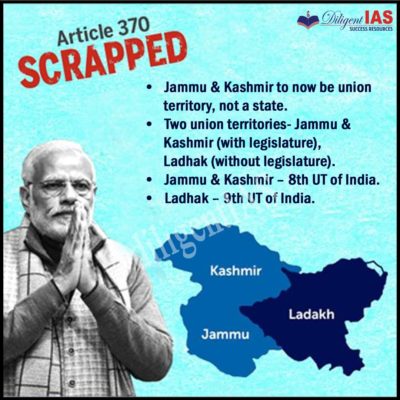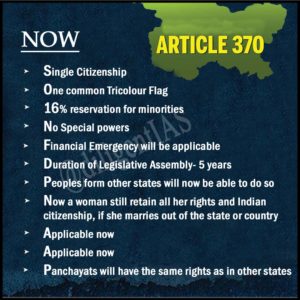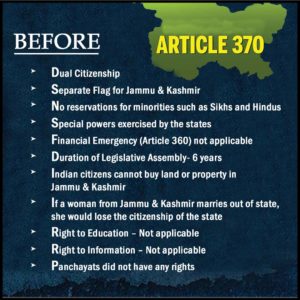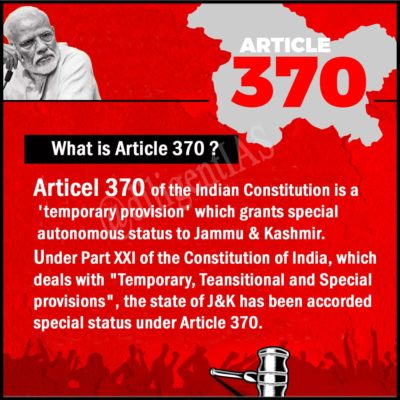Article 370 scrapped, J&K to be craved into two Union Territories 20/08/2019 – Posted in: RSTV – Tags: jammu & Kashmir, ladhak
ARTICLE 370 SCRAPPED
News Flash
On 5 August 2019, Indian President Sh.Ram Nath Kovind issued a constitutional order superseding the 1954 order, and making all the provisions of the Indian constitution applicable to Jammu and Kashmir.
After the resolutions passed in both the houses, he issued an order on 6 August declaring all the clauses of Article 370 except clause 1 to be inoperative.
This is the first time that Article 370 has been used to amend Article 367 (which deals with Interpretation) in respect of Jammu and Kashmir, and this amendment has then been used to amend Article 370 itself.

Article 370
What is Article 370?
- Incorporated into the Constitution on October 17, 1949, Article 370 exempts Jammu and Kashmir from the Indian Constitution (with the exception of Article 1 and Article 370 itself) and grants the state to draft its own Constitution.
- It restricts Parliament’s legislative powers in respect of Jammu & Kashmir.
What is the “Instrument of Accession”?
- The IoA came into play when the Indian Independence Act, 1947 divided British India into India and Pakistan.
- For some 600 princely states whose sovereignty was restored on Independence, the Act provided for three options: to remain an independent country, join Dominion of India, or join Dominion of Pakistan — and this joining with either of the two countries was to be through an IoA.
How did the accession come about?
- Raja Hari Singh had initially decided to remain independent and sign standstill agreements with India and Pakistan, and Pakistan signed it.
- But following an invasion from tribesmen and Army men in plainclothes from Pakistan, he sought the help of India, which in turn sought the accession of Kashmir to India.
- Hari Singh signed the Instrument of Accession on October 26, 1947, and Governor-General Lord Mountbatten accepted it on October 27, 1947.
What has changed in Jammu and Kashmir?
- The state of Jammu and Kashmir will now cease to exist; it will be replaced by two new Union Territories: Jammu and Kashmir, and Ladakh.
- UTs have become states earlier; this is the first time that a state has been converted into a UT.
- The UT of Jammu and Kashmir will have an Assembly, like in Delhi and Puducherry.
- Kashmir will no longer have a Governor, rather a Lieutenant Governor like in Delhi or Puducherry.
- Article 3 of the Constitution gives Parliament the power to amend the Constitution by a simple majority to change the boundaries of a state, and to form a new state.
- Jammu and Kashmir lost its special status.
- Jammu & Kashmir has been given a status lower than that of other states. Instead of 29, India will now have 28 states.
- It is also likely that corporates and individuals will be able to buy land in Jammu and Kashmir. Non-Kashmiris might now get jobs in Kashmir.
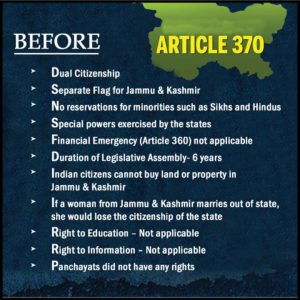
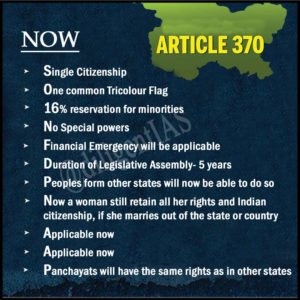
Was Article 370 a temporary provision?
- It is the first article of Part XXI of the Constitution.
- The heading of this part is ‘Temporary, Transitional and Special Provisions’.
- Article 370 could be interpreted as temporary in the sense that the J&K Constituent Assembly had a right to modify/delete/retain it; it decided to retain it.
- Another interpretation was that accession was temporary until a plebiscite.
Can Article 370 be deleted?
Yes, Article 370(3) permits deletion by a Presidential Order. Such an order, however, is to be preceded by the concurrence of J&K’s Constituent Assembly. Since such an Assembly was dissolved on January 26, 1957, one view is it cannot be deleted anymore. But the other view is that it can be done, but only with the concurrence of the State Assembly.
Present status of Jammu & Kashmir
- Article 3 of the J&K Constitution declares J&K to be an integral part of India.
- In the Preamble to the Constitution, not only is there no claim to sovereignty, but there is categorical acknowledgement about the object of the J&K Constitution being “to further define the existing relationship of the state with the Union of India as its integral part thereof.
- Moreover people of state are referred as ‘permanent residents’ not ‘citizens’.”
- Article 370 is not an issue of integration but of autonomy.
What is the status of Article 35A now?
Article 35A stems from Article 370, and was introduces through a Presidential Order in 1954. Article 35A does not appear in the principle body of the Constitution — Article 35 is followed by Article 36 — but appears in Appendix I. It (article 35A) enables the Jammu and Kashmir assembly to define the permanents occupants or residents of the state, and their extraordinary special rights and privileges.
Presidential Order has extended all provisions of the Constitution to Jammu and Kashmir, including the part on Fundamental Rights. Along these lines, the discriminatiry provisions under Article 35A are now unconstitutional/ illegal.
Why Article 35 is being challenged?
- The Supreme Court will examine whether it is unconstitutional or violates the basic structure of the Constitution.
- Article 35A was not passed as per the amending process given in Article 368, but was inserted on the recommendation of J&K’s Constituent Assembly through a Presidential Order.
Important judgments on Temporary or non-temporary provision of J&K
- In Kumari Vijayalakshmi Jha vs Union Of India (2017), Delhi High Court rejected a petition that argued that Article 370 was temporary, and that its continuation was a fraud on the Constitution.
- In April 2018, the Supreme Court said that the word “temporary” in the headnote notwithstanding, Article 370 was not temporary.
- In Santosh Kumar (2017), the apex court said that due to historical reasons, Jammu and Kashmir had a special status.
- The Supreme Court in SBI v Zaffar Ullah Nehru (2016) observed that the federal structure of the Constitution is reflected in Part XXI. The court also said that J&K has a special status, and that Article 370 was not temporary. The court referred to Article 369 of Part XXI that specifically mentions the period of five years; no time limit is mentioned in Article 370. The court observed that Article 370 cannot be repealed without the concurrence of the Constituent Assembly of Jammu and Kashmir.
- In Prem Nath Kaul (1959), a five-judge Bench of the Supreme Court observed that Article 370(2) shows that the continuance of the exercise of powers conferred on Parliament and the President by the relevant temporary provisions of Article 370(1) is made conditional on the final approval of the Constituent Assembly of Jammu and Kashmir.
- In Sampat Prakash (1968), the apex court decided that Article 370 could be invoked even after the dissolution of the Constituent Assembly of Jammu and Kashmir. “Article 370 has never ceased to be operative,” the five-judge Bench said.
Also, see related RAJYA SABHA Videos
You are on the Best Online IAS preparation platform. You are learning under experts.
We are present on Facebook- Diligent IAS, LinkedIn- Diligent IAS, YouTube- Diligent IAS, Instagram- Diligent IAS. Get in touch with us.

